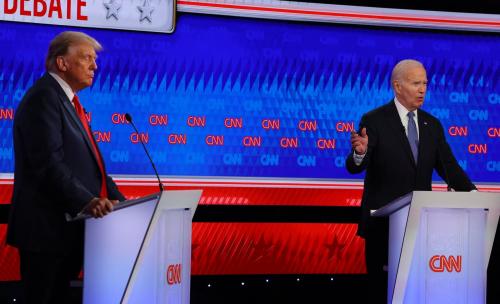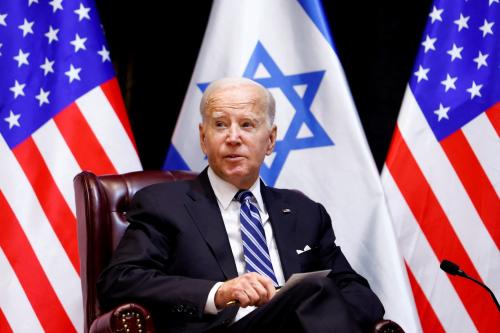The resilience of Donald Trump through the early rounds of Republican primaries and caucuses raises anew the question of just how he might govern in the event he became the 45th President of the United States. Despite his many months on the campaign trail, we know remarkably little about his policy positions on a wide range of domestic and international issues. So perhaps the time has arrived to look more closely at the existing tea leaves, ranging from prior pronouncements to early indications of what luminaries have expressed interest in joining any Trump executive team.
One of the areas of policy uncertainty concerns energy and environmental issues. There has been stunningly little discussion of these matters from any of the leading Republican candidates, aside from general dismissal of the existence of climate change and Ted Cruz’ assault on the renewable fuel standard in Iowa. Trump has generally joined the GOP chorus questioning whether there is any evidence of climate change, much less any reason to respond.
He also has taken shots a couple of times during debates at John Kasich, suggesting that the Ohio economic rebound may be due to the fact that the governor “got lucky” through expanded fracking for oil and natural gas. Trump went on record in previous years in favor of expanded fracking and boasted that he would use his influence with New York Governor Andrew Cuomo to allow such drilling in the Empire State, much as he has said he would use his powers of persuasion to compel Mexico to pay for a border security wall. He has said essentially nothing more on the subject since Cuomo ignored him and banned further pursuit of shale.
But one prominent figure with a substantial energy record has made a highly-visible endorsement of Trump and made no bones about the fact that energy is “my baby.” Indeed, former Alaska Governor Sarah Palin has made abundantly clear that her preferred path back to Washington would not entail a US Senate run but rather appointment as Energy Secretary in a Trump Administration. And Trump has not hesitated to offer effusive praise and respect for Palin as an accomplished leader.
So what would that be like—Sarah Palin as Secretary of Energy? It is no secret that Palin advocates expanded pursuit of conventional energy sources like oil and gas, as she is perhaps best known for her enthusiastic support for a “drill, baby drill” approach. But this is hardly a moment to expand government incentives to drill, given abundant supplies and collapsed prices. What is perhaps less known is how she used energy policy to fuel her rise to statewide prominence in Alaska through a populist tax policy one might not normally associate with the Republican Party.
Palin’s rise to power began not only with a small-town mayoralty but appointment to a state energy commission. This coincided with allegations of pervasive corruption in Alaska energy policy, including capture of key executives and legislators by oil interests. Palin took a populist tone, running against the “corrupt bastards’ club” of Alaskan energy insiders with zeal comparable to Bernie Sanders’ denunciation of bankers. Her signature reform was to markedly increase (already steep) state taxes on energy extraction alongside dramatic expansion of drilling opportunities.
Alaska has long been dependent on resource development, reliant upon on hefty state severance taxes and royalties to essentially fund nearly all state government services and generate ample dividend checks that arrive as pre-holiday stocking stuffers to all state residents every year. Former Republican Governor Jay Hammond was a chief architect of this system during his 1974-1982 tenure, adamant that resource taxes should “begin at 99 percent” and then decline only when absolutely necessary. Hammond was clearly a role model for Palin and continues to loom large in Alaskan life.
Palin picked up Hammond’s oil populist mantle and championed the Alaska Clean and Equitable Share (ACES) Act, sustaining a sizable base rate but adding significant increases for each dollar increase in the price of oil and gas above $50 per barrel. This included a progressive (yes, that word was used) sliding scale that skyrocketed as oil prices kept climbing. This functioned as a type of windfall profits tax, wired for maximum fiscal bounty.
Palin and her allies looked at a number of tax method and rate options, convinced that the price of oil would continue to soar and that Alaska was losing out on the latest energy bonanza. They ultimately picked a model established not by Texas or North Dakota but rather social-democratic Norway. But Team Palin bet that the future would only hold high oil prices and refused to take any of Norway’s extraordinary steps to secure a stable and robust long-term future through its oil revenue stewardship and pursuit of a diverse economy. The working assumption here was that you could go far left on taxes while going far right on drilling access, confident that a barrel of oil would stay permanently north of $90 per barrel.
You betcha, the tax produced a rapid gusher of revenue immediately, producing far more money annually than all of the carbon cap-and-trade auctions and carbon taxes in American states and Canadian provinces combined. This allowed Alaska to sustain an expansive set of expenditures and services while remaining the only state in the union to refuse to adopt a sales or income tax. And it even kept its gasoline excise tax the lowest in the nation, at eight cents per gallon. Once again, the good times were rolling in Alaska.
The vast majority of those Alaska taxes were ultimately passed along to consumers in the lower 48 or other ultimate users of Alaska’s energy outputs rather than Alaskans, though the political fingerprints are much harder to trace than most other taxes. So that explains the political correctness of Alaska oil populism, Palin-style. It also explains why these kinds of taxes have drawn rave reviews over the years by folks like Dick Cheney, Rick Perry, and Malcolm Wallop in representing their oil-generating states, though they would likely go ballistic over any other form of attaching a price to the use of fossil fuels.
But, as has happened before in Alaska, the boom times just didn’t last. Palin walked away from the governorship in the middle of her only term to explore other career options. Her hand-picked successor, Sean Parnell, had close energy industry ties and he quickly worked to slightly increase the base rate while flattening the increases at higher levels, all while sustaining substantial state investment for drilling support.
And then the bottom fell out. Given the dramatic expansion of domestic supply linked to the fracking era and the slip in international demand for oil, Alaska crude is far less attractive than it was only a few years ago. And it may not bounce back any time soon. As is customary in petro-states dominant on oil and gas revenue, Alaska has tumbled into a deep recession, one that likely would have only been worse if the Palin tax program had been sustained given the absence of high prices to apply those progressive rates.
Indeed, the fiscal situation is so dire that Independent Governor Bill Walker (elected with Palin’s support because she was so steamed about Parnell’s changes to her tax reforms) is putting some previously unthinkable options on the table. These include significant shifts and cuts in the annual dividends, development of a more diverse and sustainable tax base for the state, and budget cuts to try to navigate Alaska toward a more stable future. For the first time in a generation, there is some serious discussion about moving Alaska beyond boom-and-bust cycles that multiple governors (including Palin) fueled and ignored. Perhaps Alaska finally has a governor who refuses to treat oil and oil tax revenue as an entitlement and instead prepares the state for the future.
The person perhaps most likely to be Donald Trump’s energy secretary has said remarkably little about any of this. She readily admits that she knows little about the federal department she wants to direct, including its extensive energy research and development operations. Her main talking points in pursuing a Trump appointment are that she knows the industry and could make things hum.
In an ironic twist, the Obama Administration has taken tremendous political heat for even raising the issue of increased federal royalties on extraction on federal lands. Many of these programs were established decades ago and remain relatively modest, even while some states like Alaska have long since explored ways to leverage as much revenue as possible from energy extraction. In the case of the administration, these proposals have been directly linked to the negative externalities generated by oil, coal and gas development, much as has emerged in other states such as Colorado and North Dakota.
In these states, increasing amounts of severance tax and royalty revenues have been linked to longer-term environmental and energy issues. State leaders have been mindful of the legacies of permanently severing natural resources from below the surface of the ground that often leave fiscal and environmental ruin when markets shift or supplies ebb. Indeed, North Dakota’s Republican-led government has expressly designed its energy tax-and-spend system to avoid the legacy of Sarah Palin and other Alaska leaders, viewing their model as fiscally reckless. They are also very attentive to the Norway case, but are trying to consider the entire Norwegian package rather than just cherry pick on high tax rates.
But those lessons have been much harder to absorb in Juneau, where governors from Jay Hammond to Sarah Palin aimed to secure as much money as possible from drilling and assume that this bounty was endless. There is no real Alaska back-up plan and Walker must now contend with a political system and populace accustomed to being told by leaders that it need not pay taxes for services while they could rest assured that their dividend check would be large and deposited in their account on schedule. He surely gets my vote for a JFK Profile in Courage award for even raising these difficult issues rather than follow traditional Alaskan practice and blame the federal government when oil prices tank.
Donald Trump keeps telling Americans that he has great plans and they are going to love the results when he is President. Is there any better time than the present to elaborate on these plans, for energy and much else? Would he accept Sarah Palin’s highly-visible offer to join his cabinet? Would he embrace her Alaska energy legacy as a model for the nation? You can only talk about Ted Cruz’ citizenship and Marco Rubio’s perspiration issues for so long if you want to be the leader of the free world.



Commentary
Trump Cabinet auditions: Progressive Energy Secretary Sarah Palin?
February 24, 2016